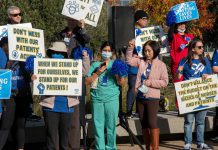Dear Editor,
Too often unreported or unpunished, crimes against animals are a
hidden epidemic in this country. Animal victims of abuse cannot
speak for themselves, so concerned citizens in our community and
our legal system must speak up for them.
Each of us has the power to fight animal cruelty, report the abusers
Dear Editor,
Too often unreported or unpunished, crimes against animals are a hidden epidemic in this country. Animal victims of abuse cannot speak for themselves, so concerned citizens in our community and our legal system must speak up for them.
Each of us has the power to fight cruelty. Any time you suspect animal abuse, your first call should be to your local humane society, animal control, or the police. Get them out there to investigate. Whether it is a neighbor’s pet being treated cruelly, cats and dogs suffering at a local pet store, or animals at a breeder’s facility being kept in filthy, crowded conditions – if it is animal abuse, it’s against the law.
This week has been named National Justice for Animals Week. For more information about how you can help end animal cruelty and abuse please visit www.aldf.org.
Katie Worth, Gilroy
Out in the garden? Be aware and avoid fines for disturbing the nests
Dear Editor,
Spring is the season for gardening and getting yards back into shape after winter rains. A word of warning: LOOK BEFORE YOU START! Before trimming tree branches and cleaning out roof gutters, check that there are no nests hidden among the leaves, in the drain, or underneath the eaves.
Why? Because it’s also baby bird season! It’s the season for parent birds to begin constructing nests, hatching eggs, and raising nestlings.
Checking for bird nests also helps ensure that you won’t inadvertently injure baby squirrels hidden inside the tree or amid the leaves.
Every year WERC and other wildlife rehabilitation facilities across the nation receive orphaned and/or injured baby birds and tree squirrels because they have lost their nests or been injured due to yard and home maintenance. Moving or disturbing the nests can hurt the animal’s chances for survival.
Even trimming trees around the nests can be detrimental, not only because of the noise and human activity can scare away the parents, but because the nest’s covering may be lost, exposing the babies to predators and the hot sun, wind, and inclement weather.
Nesting season is typically March to August. It’s against state and federal laws to remove, destroy, or disturb most nesting wild birds, their nests or their eggs. Special government permits are required to remove occupied nests and are only justified for a strongly compelling reason, for example, when the location creates a health hazard to humans.
These laws apply to homeowners, contractors, and businesses alike and violators may be prosecuted and be assessed stiff fines.
If a nest does inadvertently fall down, try to carefully place it in another part of the tree, then leave the immediate area and watch to see if the parent returns to care for the young. If the parent doesn’t come back to care for them within four hours, call WERC or your nearest licensed wildlife rehabilitation center for advice.
Sue Howell, executive director, and Colleen Grzan, animal care coordinator for the Wildlife Education and Rehabilitation Center, Morgan Hill
Spaying and neutering your pet more important now than ever
Dear Editor,
Not even the family pet is immune to the effects of the recession. Foreclosures are forcing many families out of their homes and into apartments or other rental properties, some of which do not allow pets. Many people are forced to choose between paying for food and gas or paying for pet care. Shelters and rescue organizations are swelling with surrendered pets.
Even when the economy is booming, millions of cats and dogs are euthanized every year because there are not enough homes for them. Spaying and neutering dogs and cats at an early age is more important now than ever.
Not only does spaying and neutering help control the pet overpopulation problem, it helps dogs and cats live healthier lives and eliminates or reduces many health problems that are expensive and difficult to treat. Spaying your female dog or cat eliminates the possibility of uterine or ovarian cancer, greatly reduces the incidence of breast cancer, particularly when your pet is spayed before her first estrous cycle. Neutering your male dog or cat eliminates testicular cancer and decreases the incidence of prostate disease. To avoid an unwanted litter and ensure a happier, healthier pet, spay or neuter your pet at six months of age.
There are many low-cost spay and neuter alternatives available. Most low-cost spay and neuter clinics have limited days and hours of operation.
To obtain an appointment for spaying/neutering at the St. Francis of Assisi Low Cost Spay/Neuter Clinic (12000 Murphy Ave., San Martin, (408) 683-0866), you need to call two months in advance. Please make the appointment when your pet is four months old. Your female pet may come into season (heat) at age six months.
Don’t adopt or purchase a pet on a whim. Pet care is a commitment for the life of the animal. Cats can live up to 20 years and dogs can live into their late teens.
Jayne Steinmetz, San Jose
Are cell phone towers safe to live by? It’s not clear
Dear Editor,
Recent letters to the Gilroy Dispatch regarding the health concerns some residents have about living near radiating antennas hidden on Wheeler Manor’s rooftop seem misleading. I consult on electromagnetic safety issues, and there has been an international scientific debate underway for decades concerning possible health effects of radio frequency radiation. Since the wireless industry began to mass-market cellular phones these debates have only intensified. The basic question, “Is it safe?” was not addressed when cellular phones were approved for consumer use by the FDA in 1982 and remains unresolved today.
The 1996 Telecom Act mandates the rapid deployment of antennas and sets national guidelines that concerned scientists believe are not protective enough and may be contributing to higher rates of neurological disease, cancer and other health problems among Americans. For concerned scientists, medical doctors, some policy makers and a growing number of citizens, it seems prudent to recommend limiting exposure until more is known. The FCC recommends preferential siting of antennas in commercial and industrial zones. When Gilroy adopted its current wireless siting ordinance five years ago, it signaled its intention to follow that guidance. Residents who live at Wheeler Manor and in the surrounding neighborhood are only asking T-Mobile to comply with this ordinance by locating their antennas away from this residential district.
In June, 2008, the International Commission for Electromagnetic Safety issued a resolution that states in part: “The non-ionizing radiation protection standards (for wireless transmitters, including cellular antennas) recommended by international standards organizations, and supported by the World Health Organization, are inadequate. Existing guidelines are based on results from acute exposure studies. A world wide application of the Precautionary Principle (which means “when there are indications of possible adverse effects, though they remain uncertain, the risks from doing nothing may be far greater than the risks of taking action to control these exposures”), as is required, until biologically based standards are determined. In addition, new standards should be developed to take various physiological conditions into consideration, e.g., pregnancy, newborns, children, and elderly people.”
In fact, the FDA now recommends children and teens limit their use of cellular phones as does Finland, France, the United Kingdom. Sweden, Thailand and many other nations. Moreover, nine European Union countries, Switzerland, Russia and China have adopted lower antenna safety limits than the U.S. and some of these countries are creating low EMF emitting products and designating low EMF zones in sensitive areas such as, near schools, residential neighborhoods and places where children, seniors and those with health problems spend a lot of time.
The decision to use personal wireless communications devices is a choice adults can make. Being forced to live in the shadow of a nearby radiating antenna is involuntary. It took many years from the initial studies linking cigarettes to lung cancer before the U.S. Surgeon General issued a health warning on smoking as a cancer causing agent and even longer to acknowledge that second hand smoke also posed a serious health risk. Again, a precautionary approach is wise.
Gilroy can decide whether it wants to be known as a city that cares about the health and well being of its residents versus one that caves in to pressure from the wireless industry.
Elizabeth Kelley, Gilroy












